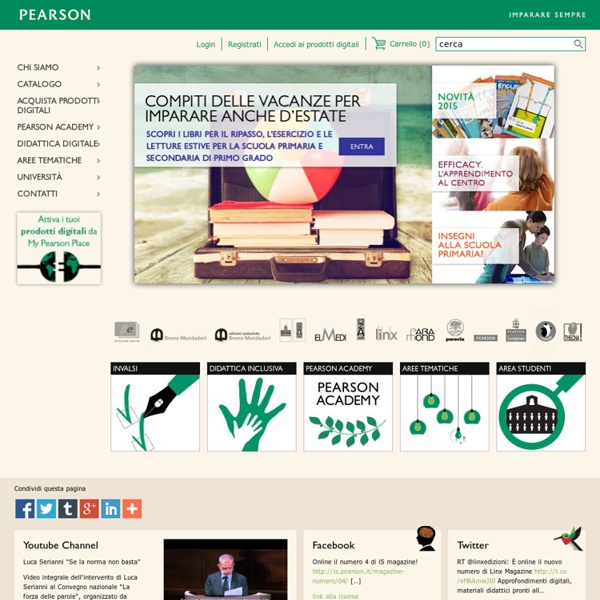



Home - The Together Teacher The Together Teacher if you like writing The second-person narrator, though not very common, is present in literature and media. For example, the posts I publish in this site are directed at you, dear reader, and this is why I resort to the second-person narrator. This type of narrator is also typical of the epistolary form; in fact, many novels contain letters or emails the characters send to each other. Nevertheless, the addressee of the second-person narrations I want to analyze in this post is not a character, but the reader himself (or herself). For instance, in Italo Calvino’s If on a Winter's Night a Traveler, the second-person narrator acts as the master in a role-playing game, trying to get the reader to identify with the main character. A much more recent example is Paul Auster’s Winter Journal.
Tecniche di didattica inclusiva in un ebook scaricabile gratuitamente | Lim e dintorni Posted on settembre 23, 2015 by tutor lim Tecniche di didattica inclusiva: ebook scaricabile gratuitamente Sourced through Scoop.it from: www.robertosconocchini.it See on Scoop.it – Lim Mi piace: Mi piace Caricamento... Filed under: Uncategorized lepidascuola A New Way to Introduce the Color Wheel I recently took a graduate class titled “Supports for English Language Learners.” In this class I learned various strategies to use when teaching English Language Leaner’s. I was also reminded of the importance of incorporating vocabulary and visual aids in my lesson plans. . . In order to complete the activity, students need to be in groups of two. The bottom of the stick is colored with marker and the name of the color written on it. I put these three sentences on the board for them to read: 1. 2. 3. _______________ is a _________________________________ color. Here is an example of how they would read the sentences: The name of my color is blue. Each student repeats the activity until all students have a popsicle stick. The students take turns pulling out a color swatch from the envelope. The students really liked this activity and I have repeated it multiple times because of its success. How could you use sentence starters in your classroom?
Press 29 ottobre Deleghe Buona Scuola Dal 29 settembre al 29 ottobre 2015 sono convocati i tavoli di confronto sulle deleghe legislative previste dalla Legge 107/15 Piano Nazionale Scuola Digitale Roma, 27 ottobre 2015 Al via la seconda edizione di Libriamoci 26 - 31 ottobre 2015 Presentazione del nuovo Pon Scuola Roma, 23 ottobre 2015 OLTRE questa Riforma della scuola Lecce, 17 ottobre 2015 15 ottobre Legge di Stabilità 2016 in CdM Il Consiglio dei ministri approva i disegni di legge riguardanti le Disposizioni per la formazione del bilancio annuale e pluriennale dello Stato ed il Bilancio di previsione dello Stato per l’anno finanziario ... 15 ottobre Bonus per la formazione dei docenti Il MIUR fornisce indicazioni operative riguardo al bonus per la formazione previsto dall'art. 1, c. 121, della Legge 107/15, in ragione dei criteri e delle modalità di assegnazione e utilizzo della Carta ... 13 ottobre Revisione parte seconda Costituzione al Senato 11 ottobre Registro giornaliero di protocollo Agosto 2015
Classroom 2.0 Come trasformare un telefonino in videoproiettore In periodi di spending review, riuscire a trasformare un telefonino in un videoproiettore con meno di 4 dollari credo sia il massimo! In effetti per riuscire nell'impresa servono cartoncino nero, una scatola delle scarpe, nastro isolante nero, una lente d'ingrandimento e un graffetta. Tutte le istruzioni per il montaggio le trovate in www.thistlewoodfarms.com, con ampio corredo fotografico per mostrare come posizionare il telefonino all'interno della scatola e come mettere a fuoco le immagini. Un'altra dimostrazione simile la trovate in Photojojo
Insegnanti 2.0 | Insegnare nell'era digitale MOOCs are Changing the Way the World is Educated - Webologist In the last few years I have seen, and participated in, some excellent online courses that are run by some of the world’s top universities. My introduction to free online education was when FutureLearn sent me an email to introduce some of their first courses. Today I heard about Coursera, another provider of Massive Open Online Courses (MOOC), in a BBC article. MOOCs are becoming the hot new thing. Anant Agarwal, a computer architecture researcher at MIT, started his discussion about Moocs with: “I would like the re-imagine education”. Futurelearn My experience so far has only been with FutureLearn, which is owned by the Open University (I studied Health Sciences with the OU a few years ago, which is why I got an email about Futurelearn). I actually received an email just when I was researching courses to help improve my writing (did it work???) FutureLearn’s Simon Nelson addressed delegates at the EMOOCs 2014 Conference – watch the video here. Global education Coursera No qualifications
The Epic BYOD Toolchest (51 Tools You Can Use Now) | My Educational Technology Blog: A Place of Resources and Tools for Educators Reblogged from Edutopia Formative Assessment Socrative: My all-time favorite app for formative assessment runs on everything. Screencasting and Capturing What Happens in Class If you’re going to share and interact with your students in the electronic and physical spaces (as you should), you must learn how to screencast. Screencastomatic: This is my go-to app. Content-Sharing Platforms Your school is bricks and clicks. Sophia: Nudged along by my friend Todd Nesloney, I use Sophia for my computer applications instruction and am very pleased with the results.Haiku Learning: This is the full content management system that I’m trying to get our school to adopt. There are many other apps like Moodle, Canvas, and Coursesites. Assessment Aids Electronic Note Taking There are two frontrunners in this category, in my opinion. Expression Cloud Syncing Presentations